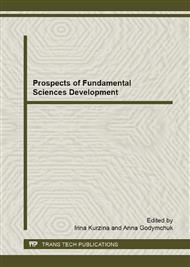[1]
B. Budiansky, R. J. O'Connell, Elastic moduli of a cracked solid, Int. J. Solids Struct. 12 (1976) 81-97.
Google Scholar
[2]
J. Aboudi, Stiffness reduction of cracked solids, Eng. Fatigue Mech. 26 (1987) 637-650.
DOI: 10.1016/0013-7944(87)90129-9
Google Scholar
[3]
J. Krautkramer, H. Krautkramer, Ultrasonic testing of materials. Springer, New York (1990).
Google Scholar
[4]
D. E. Bray, R. K. Stanley, Nondestructive evaluation, CRC Press, New York. (1997).
Google Scholar
[5]
S. -H. Kee, J. Zhu, Surface wave transmission measurements across distributed surface-breaking cracks using air-coupled sensors, J. Sound Vib., 330 (2011) 5333-5344.
DOI: 10.1016/j.jsv.2011.05.034
Google Scholar
[6]
D. Dhital, J. R. Lee, A Fully Non-Contact Ultrasonic Propagation Imaging System for Closed Surface Crack Evaluation, Exp. Mech. 52 (2012) 1111-1122.
DOI: 10.1007/s11340-011-9567-z
Google Scholar
[7]
S. -H. Kee, J. Zhu, Using air-coupled sensors to evaluate the depth of a surface-breaking crack in concrete, J. Acoust. Soc. Am. 127 (2010) 1279-1287.
DOI: 10.1121/1.3298431
Google Scholar
[8]
W. J. Song, J. S. Popovics, J. C. Aldrin, S. P. Shah, Measurement of surface wave transmission coefficient across surface-breaking cracks and notches in concrete, J. Acoust. Soc. Am. 113 (2003) 717-725.
DOI: 10.1121/1.1537709
Google Scholar
[9]
S. -W. Liu, J. -C. Sung, C. -S. Chang, Transient scattering of Rayleigh waves by surface-breaking and sub-surface cracks, Int. J. Eng. Sci. 34 (1996) 1059–75.
DOI: 10.1016/0020-7225(95)00143-3
Google Scholar
[10]
D. G. Aggelis, E. Leonidou, T. E. Matikas, Subsurface crack determination by one-sided ultrasonic measurements, Cem. Concr. Compos. 34 (2012) 140-146.
DOI: 10.1016/j.cemconcomp.2011.09.017
Google Scholar
[11]
L. J. Jacobs, J. O. Owino, Effect of aggregate size on attenuation of Rayleigh surface waves in cement-based materials, J. Eng. Mech. 126 (2000) 1124–1130.
DOI: 10.1061/(asce)0733-9399(2000)126:11(1124)
Google Scholar
[12]
A. P. Surzhikov, T. V. Fursa, Mechanoelectrical transformation upon the elastic impact excitation of composite dielectric materials, Technical Physics. 53 (2008) 462-465.
DOI: 10.1134/s1063784208040117
Google Scholar
[13]
T. V. Fursa, D. D. Dann, Mechanoelectrical transformations in heterogeneous materials with piezoelectric Inclusions, Technical Physics. 56 (2011) 1112–1117.
DOI: 10.1134/s1063784211080093
Google Scholar
[14]
T. V. Fursa, B. A. Lyukshin, G. E. Utsyn, Relation between the electric response and the characteristics of elastic waves under shock excitation of heterogeneous dielectric materials with piezoelectric inclusions, Technical Physics. 58 (2013).
DOI: 10.1134/s1063784213020096
Google Scholar


